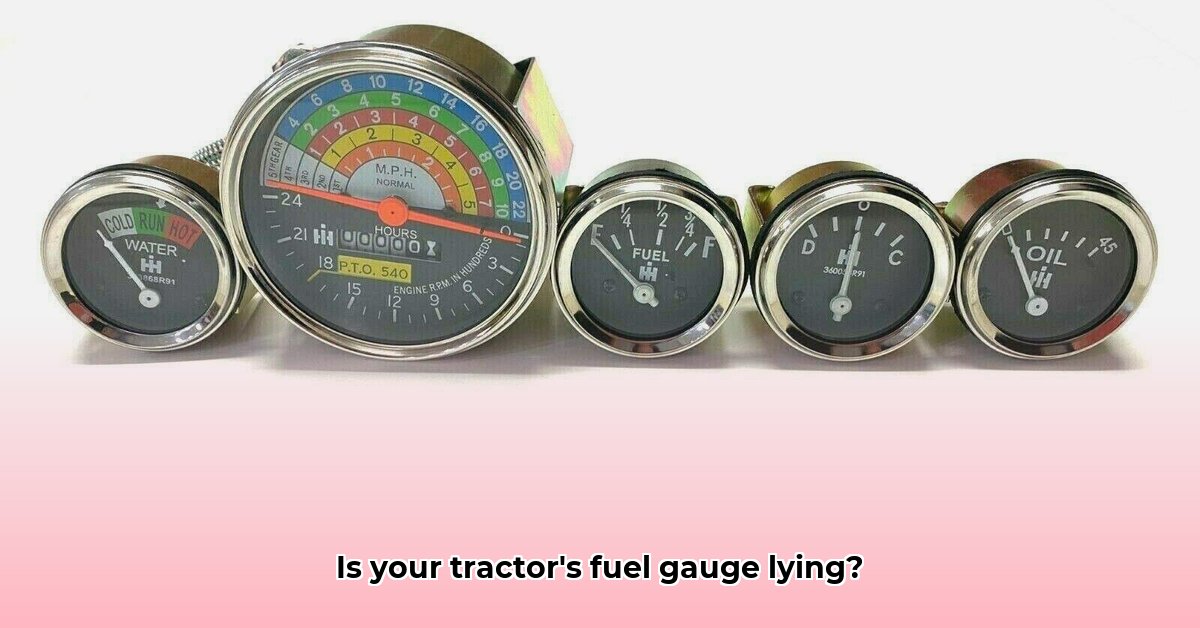
Finding the right fuel gauge for your tractor can be tricky, especially with older models. This guide simplifies the process, from understanding your tractor's system to installing and upgrading your fuel gauge. For more resources on tractor fuel systems, check out this helpful resource: Tractor Fuel Systems.
Understanding Your Tractor's Fuel Gauge System
A malfunctioning fuel gauge can lead to unexpected downtime. Before you buy a replacement, you need to understand your tractor's fuel system. Think of it as a unique fingerprint: every tractor is different. Knowing your tractor's make, model, year, and engine type is crucial for finding the correct part. Even seemingly identical tractors can have different fuel gauge systems.
Another key factor is your tractor's electrical system: does it use positive or negative grounding? This is vital because incorrect wiring can damage your new gauge. Think of it like connecting house wires incorrectly – a short circuit can occur.
How can you find this information?
- Consult your owner's manual: This is the best source for specifics about your tractor's fuel system and electrical setup.
- Use online tractor communities: Forums dedicated to your tractor model are goldmines of information. Owners have likely encountered similar issues and can offer invaluable advice.
- Examine your old gauge: The old gauge itself may provide clues. Look for part numbers, model codes, or any markings that can help identify it.
Finding and Installing the Right Fuel Gauge
Finding a replacement gauge involves careful research and cross-referencing. Online marketplaces offer a wide selection, but inaccuracies in part numbers are common. OEM (Original Equipment Manufacturer) parts are ideal, ensuring a perfect fit, but can be expensive and hard to find. Aftermarket gauges are more readily available and often more affordable, but compatibility must be verified.
Here's a step-by-step guide to installation:
- Prioritize Safety: Always disconnect the negative terminal of your tractor's battery before starting any electrical work. This prevents electrical shocks and potential damage.
- Careful Removal: Gently remove the old gauge. Take detailed photos of the wiring before disconnecting anything to aid in reinstallation.
- Precise Installation: Install the new gauge, carefully matching the wiring connections. Verify the ground wire is correctly connected (positive or negative, depending on your tractor).
- Thorough Testing: Reconnect the battery and test the new gauge thoroughly. If there are issues, double-check the wiring and consult online resources for troubleshooting.
Beyond Replacement: Upgrading Your Gauge System
Replacing your fuel gauge addresses an immediate problem, but consider upgrading to a more modern system for enhanced accuracy and functionality. This can provide more data beyond simple fuel levels.
Here's a comparison of upgrade options:
| Upgrade Option | Advantages | Disadvantages |
|---|---|---|
| Digital Gauge System | Precise readings, often with extra data | Higher initial cost, may need electrical work |
| Integrated Gauge Cluster | All-in-one solution, improved aesthetics | More complex installation, usually expensive |
Modern “smart” gauges offer real-time fuel data, low-fuel warnings, and may even connect to farm management systems. However, these can be significantly more expensive. The best upgrade option depends on your budget and tractor's needs. Remember, precise tractor identification is essential for compatibility.
Key Takeaways:
- Accurate tractor identification (make, model, year, engine) is essential for finding the correct fuel gauge.
- Online resources like Yesterday's Tractors (https://www.yesterdaystractors.com/) are invaluable for finding parts for older tractors.
- Understanding your tractor's grounding system (positive or negative) is critical for safe and correct gauge installation.
- Aftermarket gauges might require adjustments for optimal fit and function. Always double-check compatibility.
- Preventative maintenance, such as cleaning connectors, can extend your gauge's lifespan.